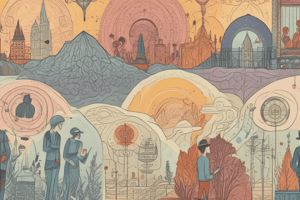Podcast
Questions and Answers
What defines an infection?
What defines an infection?
- A state where the body is free from microbes.
- When the body has no pathogens present.
- A naturally occurring immunity to diseases.
- A condition where pathogens enter the body and multiply. (correct)
Which type of pathogen is the smallest and considered non-living?
Which type of pathogen is the smallest and considered non-living?
- Fungi
- Bacteria
- Protozoa
- Virus (correct)
During which stage of infection do the signs and symptoms start to appear?
During which stage of infection do the signs and symptoms start to appear?
- Prodromal Stage (correct)
- Acute Stage
- Incubation Stage
- Convalescent Stage
Which stage of infection is characterized by recovery and fading symptoms?
Which stage of infection is characterized by recovery and fading symptoms?
What is a common characteristic of bacteria?
What is a common characteristic of bacteria?
Which type of pathogen multiplies like viruses but is smaller than bacteria?
Which type of pathogen multiplies like viruses but is smaller than bacteria?
What is the incubation stage of infection?
What is the incubation stage of infection?
What occurs during the declining stage of infection?
What occurs during the declining stage of infection?
Which of the following features distinguishes protozoa from bacteria?
Which of the following features distinguishes protozoa from bacteria?
Fungi can cause which types of diseases?
Fungi can cause which types of diseases?
Flashcards
What is infection?
What is infection?
A condition where disease-causing organisms enter the body and multiply, leading to illness.
What are pathogens?
What are pathogens?
Disease-causing microorganisms, such as bacteria, viruses, fungi, and protozoa.
What are viruses?
What are viruses?
The smallest disease-causing pathogen, considered non-living, that reproduces by infecting cells and directing them to produce more viruses.
What are bacteria?
What are bacteria?
Signup and view all the flashcards
What are protozoa?
What are protozoa?
Signup and view all the flashcards
What are fungi?
What are fungi?
Signup and view all the flashcards
What are rickettsia?
What are rickettsia?
Signup and view all the flashcards
What is the incubation stage?
What is the incubation stage?
Signup and view all the flashcards
What is the prodromal stage?
What is the prodromal stage?
Signup and view all the flashcards
What is the acute stage?
What is the acute stage?
Signup and view all the flashcards
Study Notes
Document Metadata
- From: Saved by Blink
- Subject: Week 21-HEALTH-CN-3.2.-Infecion.docx
- Date: Saturday, January 18, 2025
- MIME-Version: 1.0
- Content-Type: multipart/related
- Boundary: - ---MultipartBoundary--3mLaB3d0p7MhTQzSz3VPCX5NsuGASbB8B0nu6h55yC----
Document Content
- ARELLANO UNIVERSITY
- JOSE RIZAL HIGH SCHOOL
- Address: Gov. Pascual Ave., Malabon City
- Contact: 921-27-44
- Accreditation: PACUCOA Accredited, Level II
- School Year: 2024-2025
- Teacher: Mrs. Ruby S. Dayao
- Grade and Section: (Information missing)
- Date: (Information missing)
- Student Name: (Information missing)
- Topic: Week 21-HEALTH-CN-3.2.-Infecion.docx
- Document Content: The document contains detailed HTML and CSS code representing the contents of a website.
- Document Content Sections: This document likely describes the stages of infection and related information.
- Information: The information included in the body of the document focuses on defining infection, disease-causing organisms (pathogens), and the different types of pathogens such as virus, bacteria, and fungi, and the stages of infection (incubation, prodromal, acute, declining, and convalescence stages).
Studying That Suits You
Use AI to generate personalized quizzes and flashcards to suit your learning preferences.




